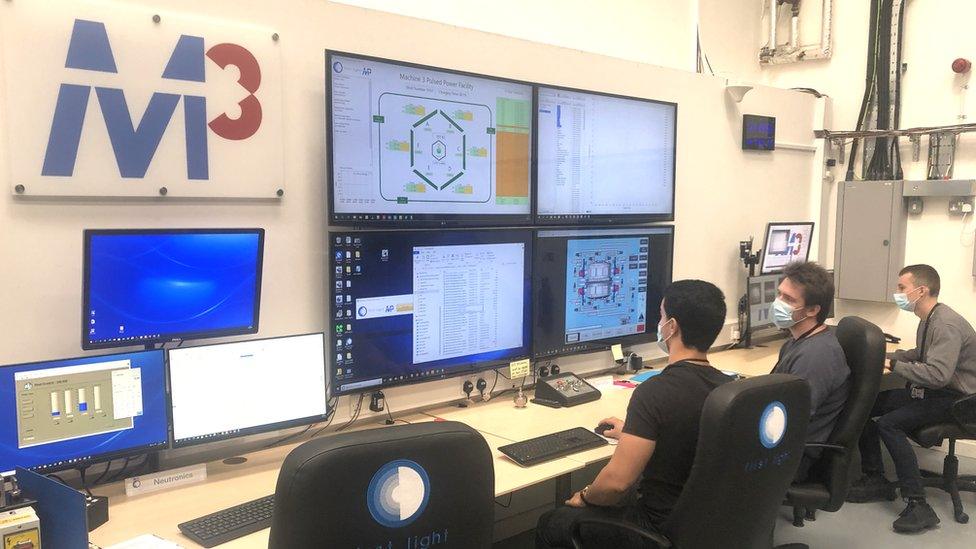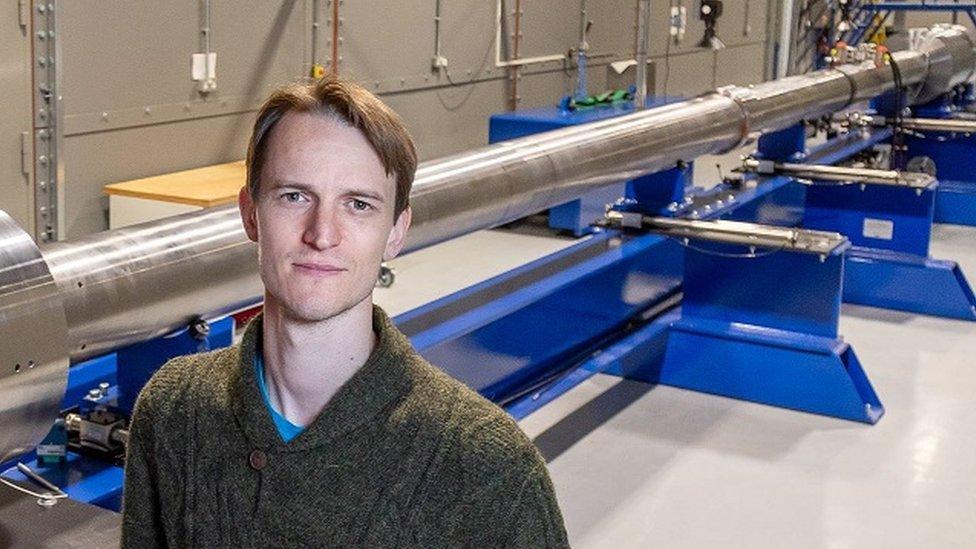Clean energy from the fastest moving objects on earth
- Published

The control room for Machine 3
"You might want to cover your ears," a senior engineer at First Light Fusion tells me, as we gaze at a bank of screens that looks like a mini version of a Nasa control room. I reach for some ear plugs.
A warning siren is sounding and a computerised voice counts up the level of electrical charge in an extraordinary machine.
It has been built by First Light Fusion - an Oxford-based company trying to recreate here on Earth the reaction that powers the Sun.
Shortly after it is fully-charged, Machine 3 makes a considerable bang as switches fly open and 9 million amps - equivalent to around 300 lightning strikes - is concentrated into an area the size of your finger nail.
That electricity is then used to generate an electromagnetic force which accelerates a small aluminium disc to speeds of up to 20km-per-second, making it one of the fastest moving objects humans have ever created.
It's hard to imagine that kind of speed, but something going that fast would rocket from London to Paris in a little over 20 seconds.

Machine 3: The blue parts are capacitors which store the charge needed to accelerate the projectile
The aluminium disc is not going far though - it has been launched through a vacuum at a special target just 10mm away.
Exactly what the target is made of, its proportions and internal structure, however, are top secret. That's because First Light has spent several years, and millions of pounds, designing the target to collapse so it crushes a small bubble of fuel under tremendous pressure and heat.
Why? Because with enough pressure you can get that fuel (isotopes of hydrogen, called Deuterium and Tritium), to fuse together into helium.
During that process, known as fusion, fast-moving particles called neutrons are produced and their energy can be captured and this is the crucial bit, converted to heat, which can be used to make electricity.
If all that chemistry and physics is a little baffling then don't worry, the important point is that producing energy this way would be a huge breakthrough for industry.
Fusion only needs relatively small amounts of fuel. Fusion also does not produce any greenhouse gases and you end up with little of the radioactive waste that makes current nuclear reactors so unpopular.
"This is going to be as significant as going from wood to fossil fuels in terms of what it means for civilization... or you could say from fossil fuels to renewables. This is a new, unlimited source of energy," says Nicholas Hawker, a co-founder of First Light and its chief executive.

In this prototype target on the left you can see the bubble which would hold the fuel - the bubble on the right is a reflection
Interest in such a potentially clean source of energy has increased in the run-up to the COP26 climate conference, which starts 31 October in Glasgow.
The downside to fusion, however, is that it is very difficult to sustain and contain, due to the high temperatures and pressures required.
Mr Hawker thinks First Light is very close to achieving fusion in Machine 3. But with the usual caution of a scientist, Mr Hawker does not want to predict exactly when that will happen, and will want to carefully check any results.
While that will be an impressive achievement, there is at least a decade of work before First Light can build a working reactor that can keep the process going, and capture the heat to make energy.


But Mr Hawker is confident his team can get there. "It's not a fantasy," he tells me.
"I really think we have the most unblocked, most scalable technology that can be built with the lowest risk, lowest cost and that's what it's about."
Once their current machines have demonstrated fusion, then the next step will be to be to build a machine that can produce more energy than it uses - so called "gain".
That is going to require an even more powerful machine that can generate higher speeds, perhaps as high as 50km per second.
Over the decade they hope to get that running, at the same time planning their first reactor, which they hope will be ready for testing in the 2030s.

"It's not a fantasy," says First Light Fusion founder Nicholas Hawker
Mr Hawker admits there are engineering challenges though: not least, firing their high-speed projectile over longer distances and still hitting the target.
"We don't know if it's a showstopper, but it's the most difficult engineering challenge. Accurately launching the projectile at the required repeat rate. That's the biggest engineering challenge for us," he says.
Competitors
He is also racing dozens of other firms who are developing their own technologies for getting fusion to work.
Here in the UK, Tokamak Energy is attracting attention with its progress. Instead of firing a projectile to create the conditions for fusion, it heats the fuel to extreme temperatures and then captures the resulting plasma with powerful magnetic fields in a device known as a tokamak.
Arthur Turrell has a PhD in plasma physics and is the author of "The Star Builders" a book about the efforts to make fusion work.
Turrell admires the work done by private firms like First Light and Tokamak Energy, but points out they are not the furthest advanced in the field.
"Fusion firms are doing really interesting things, and they're catching-up on decade's worth of progress in public labs. But none of them have yet got anywhere close to the conditions achieved in public laboratories. It doesn't mean it won't happen. But they're just not there yet," he says.

The National Ignition Facility in California fires lasers at fuel pellets
For example in August the National Ignition Facility (NIF), external, in California, made an important breakthrough by sparking a fusion reaction that produced 70% of the energy needed to get the reaction going in the first place.
NIF focuses powerful laser beams on a pellet of fuel to generate conditions for fusion, and Mr Turrell thinks it is only a matter of time before they start getting more energy out of the reactions than they put in.
While the big publicly-funded fusion projects are out in front, for now, to tackle such a tricky problem it makes sense to have multiple players develop their own technology, says Mr Hawker.
"We don't know, ultimately, what will work for commercialisation. So people exploring lots of different options, [means] we've got a much better chance of hitting upon something that works."
Follow Technology of Business editor Ben Morris on Twitter, external.